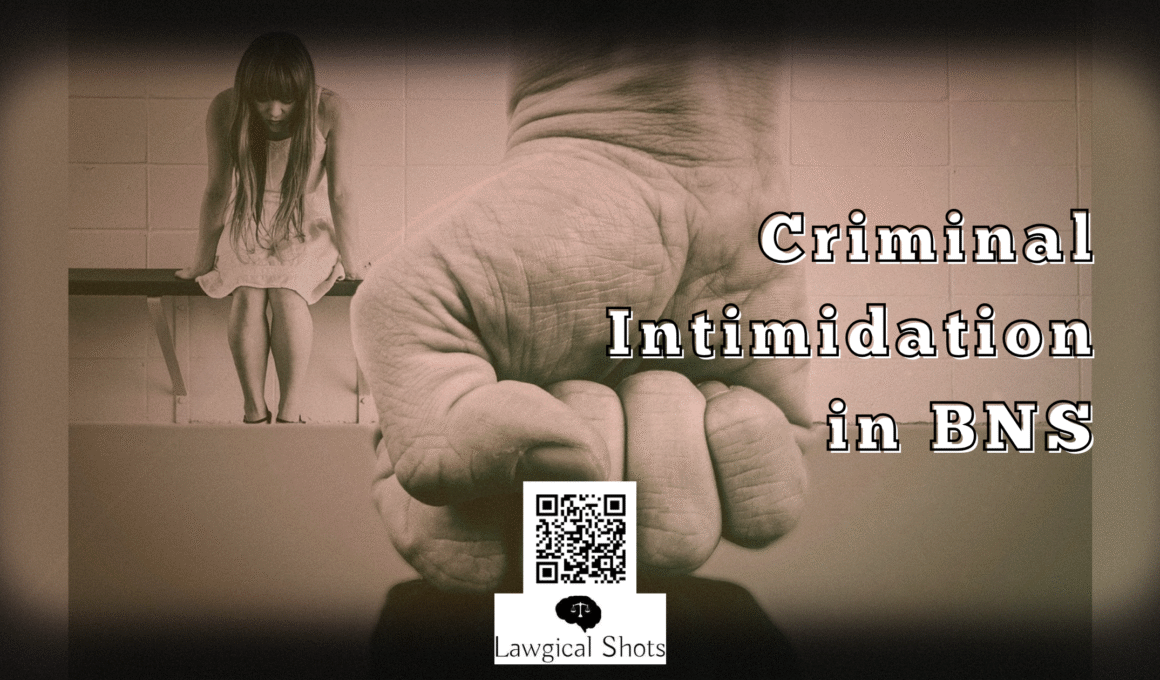Someone you know comes to your house with a big smile on their faces, but since it was a property related dispute underneath, they left threatening you for your life, house, and societal reputation. What do you do in that case? Because they just yelled and left, they did not actually harm you. You are short of breath praying for your life, but will someone take it seriously, since nothing happened and you did even get a scratch? Let me tell you, the authorities will. This is an offence, known as criminal intimidation in BNS 2023. The technicalities of the legal provisions have been explained hereunder with one task at a time.
What is BNS Section for 506 IPC?
Section 351 of the Bharatiya Nyaya Sanhita, 2023 contemplates the provisions of Sections 506, 507 and 508 of the Indian Penal Code, 1860. The definition, different scenarios pertaining to the offence, and criminal intimidation punishment under BNS have been provided under Section 351.
Criminal Intimidation in BNS 2023
As mentioned earlier, the three Sections of IPC have been incorporated under the 4 sub-sections of Section 351 of the BNS. Given below is the actual provision accompanied with its explanatory comment to make things easier:
Section 351 of BNS
“351. Criminal Intimidation – (1) Whoever threatens another by any means, with any injury to his person, reputation or property, or to the person or reputation of any one in whom that person is interested, with intent to cause alarm to that person, or to cause that person to do any act which he is not legally bound to do, or to omit to do any act which that person is legally entitled to do, as the means of avoiding the execution of such threat, commits criminal intimidation.”
Comment: Earlier encapsulated in Section 503 of the IPC, Section 351(1) defines what criminal intimidation is. It lays that whenever someone threatens another person with injury to the person, his/her reputation or property, or someone connected to him/her is said to commit criminal intimidation. There must be intention to cause alarm or do any act which is against the law, or abstain from doing something which he/she is legally entitled to do.
For example, when Rishi threatened Juhi to divorce her husband, or Rishi will defame her husband in a way that he would lose his job and societal reputation, Rishi would be liable for criminal intimidation.
“Explanation.—A threat to injure the reputation of any deceased person in whom the person threatened is interested, is within this section.”
Comment: The explanation here was part of the explanation to Section 503 of IPC. It reflects that the reputation here may also pertain to a person who is deceased, and the one being threatened is interested in such deceased. In the absence of this explanation, the term “person” may only include those alive at that time.
“(2) Whoever commits the offence of criminal intimidation shall be punished with imprisonment of either description for a term which may extend to two years, or with fine, or with both.”
Comment: The very famous IPC Section 506 laid the criminal intimidation punishment. The same has been provided under Sub-Section 2 of Section 351 BNS. As stated, the maximum punishment for criminal intimidation BNS is 2 years. The extent of imprisonment or imposition of fine is the discretion of the Judge.
“(3) Whoever commits the offence of criminal intimidation by threatening to cause death or grievous hurt, or to cause the destruction of any property by fire, or to cause an offence punishable with death or imprisonment for life, or with imprisonment for a term which may extend to seven years, or to impute unchastity to a woman, shall be punished with imprisonment of either description for a term which may extend to seven years, or with fine, or with both.“
Comment: While Section 506 lay the definition of criminal intimidation, it also laid the punishment for when the threat pertained to causing death or grievous hurt, etc. The same has been incorporated under Section 351(3) of BNS. The sub-section states punishment when someone intimidates another of causing death of grievous hurt, or destruction of property by fire, or any offence punishable with death/life imprisonment/7-years imprisonment. Such a person is punishable with imprisonment up to 7 years, with or without fine. What can be understood here is the gravity of threat led to the increase in maximum punishment from 2 to 7 years of imprisonment.
“(4) Whoever commits the offence of criminal intimidation by an anonymous communication, or having taken precaution to conceal the name or abode of the person from whom the threat comes, shall be punished with imprisonment of either description for a term which may extend to two years, in addition to the punishment provided for the offence under sub-section (1).”
Comment: Anonymity is a bliss unless you use it for committing an offence. IPC Section 507 or BNS Section 351 (4) lays about Criminal intimidation by an anonymous communication. Anonymous communication means communication with someone without revealing identity. As compared to otherwise, criminal intimidation without revealing identity to the person who is being intimidated attracts double the punishment. As specified, the punishment in Sub-Section adds to the maximum punishment of 2 years for anonymity.
Example: Someone slipped a note in Riya’s place to leave the apartment within a week or her apartment would be set on fire. In this case, the intimidator, if caught, would be punished for anonymity along with criminal intimidation.
Criminal Intimidation Punishment in BNS
The criminal intimidation BNS punishment differs based on the extent of the act. If the intimidation tends to reflect hurt on a person or reputation, the maximum punishment is imprisonment for 2 years. If things get serious and the threats go grave with those of causing death or grievous hurt, or any such serious offence, the punishment goes up to 7 years. It may be noted that identity also plays a major role in deciding the extent of punishment for criminal intimidation. If it is a case of hidden identity, criminal intimidation punishment comes at the added cost of anonymity of up to 2 years of imprisonment.
What can be seen is that the gravity of facts and circumstances extend a lot of discretion to the Judge while deciding the offence of criminal intimidation. Imposition of fine is yet another aspect of such discretion.
Criminal Intimidation BNS – Bailable or Non-Bailable?
As provided under First Schedule to the Bharatiya Nagarik Suraksha Sanhita, 2023, the offence of criminal intimidation, is bailable, triable by Any Magistrate. The threat to cause death or grievous hurt as well as the one committed anonymously, both are bailable offences, triable by the Magistrate of First Class.
Is Criminal Intimidation a Cognizable Offence?
As per the First Schedule to BNSS 2023, criminal intimidation (any offence under Section 351 – grave or not) is a non-cognizable offence. This means that the Police Officer cannot arrest a person accused of criminal intimidation without warrant. For arrest in criminal intimidation under BNS, the Police Officer needs a warrant, or say permission from a Magistrate, to begin with investigation.








